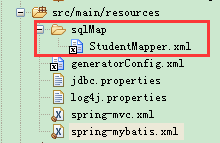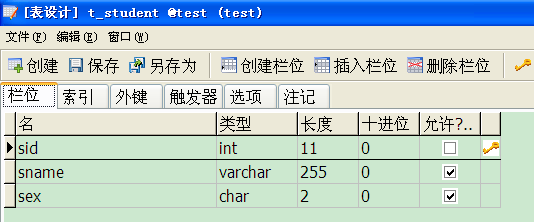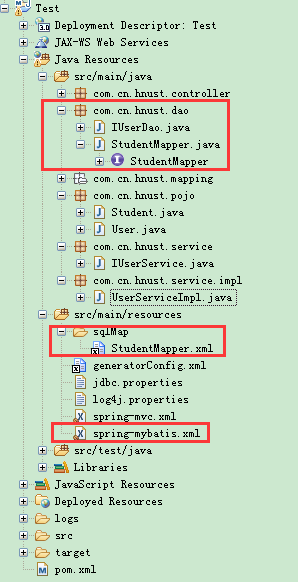maven插件mybatis-generator生成代码配置
鸣谢:http://my.oschina.net/u/1763011/blog/324106?fromerr=nJakGh4P (也可参看此博客进行配置)
http://www.cnblogs.com/zcy_soft/p/3358132.html(补充1)
http://blog.csdn.net/sunny243788557/article/details/45166397 (补充2)
http://www.cnblogs.com/yjmyzz/p/4210554.html (补充3)
http://www.myexception.cn/software-architecture-design/621662.html (补充4)
http://mbg.cndocs.tk (MyBatis Generator介绍)
http://blog.csdn.net/isea533/article/details/42102297 (MyBatis Generator详解)
http://www.cnblogs.com/daxin/p/3545040.html (Mybatis MapperScannerConfigurer 自动扫描 将Mapper接口生成代理注入到Spring)
---------------------------------------------------------------------------------------------------------------------------
测试项目:Test
1.新建maven项目
2.pom.xml文件中添加插件,如:
<build>
<finalName>org.zsl.hnust</finalName>
<plugins>
<plugin>
<groupId>org.mybatis.generator</groupId>
<artifactId>mybatis-generator-maven-plugin</artifactId>
<version>1.3.2</version>
<configuration>
<verbose>true</verbose>
<overwrite>true</overwrite>
</configuration>
</plugin>
</plugins>
</build>
3.在项目的/src/main/resources(默认目录)的文件目录下加入generateConfig.xml
如:
<?xml version="1.0" encoding="UTF-8" ?>
<!DOCTYPE generatorConfiguration PUBLIC "-//mybatis.org//DTD MyBatis Generator Configuration 1.0//EN" "http://mybatis.org/dtd/mybatis-generator-config_1_0.dtd" >
<generatorConfiguration>
<classPathEntry
location="D:\repo\mysql-connector-java-5.1.26.jar" />
<context id="context1" targetRuntime="MyBatis3">
<commentGenerator>
<!-- 是否去除自动生成的注释 true:是 : false:否 -->
<property name="suppressAllComments" value="true" />
</commentGenerator> <jdbcConnection driverClass="com.mysql.jdbc.Driver"
connectionURL="jdbc:mysql://localhost:3306/test"
userId="root" password="" />
<javaModelGenerator targetPackage="com.cn.hnust.pojo"
targetProject="D:\Eclipse_Workspace\HNUST\org.zsl.hnust Maven Webapp\src\main\java" /> <sqlMapGenerator targetPackage="com.cn.hnust.mapping"
targetProject="D:\Eclipse_Workspace\HNUST\org.zsl.hnust Maven Webapp\src\main\java" /> <javaClientGenerator type="XMLMAPPER" targetPackage="com.cn.hnust.dao"
targetProject="D:\Eclipse_Workspace\HNUST\org.zsl.hnust Maven Webapp\src\main\java">
</javaClientGenerator> <table tableName="t_student" domainObjectName="Address"
enableCountByExample="false" enableUpdateByExample="false" enableDeleteByExample="false"
enableSelectByExample="false" selectByExampleQueryId="false" >
<property name="useActualColumnNames" value="true"/>
</table>
</context>
</generatorConfiguration>
注:
javaModelGenerator :指定生成pojo的包和此包在项目中的地址;
sqlMapGenerator :指定生成pojo的映射xml文件的所在包和此包在项目中的地址;
javaClientGenerator :指定生成访问映射xml文件的接口所在包和此包在项目中的地址;
table属性:
enableCountByExample="false"
enableUpdateByExample="false"
enableDeleteByExample="false"
enableSelectByExample="false"
selectByExampleQueryId="false"
schema为数据库名, tableName为对应的数据库表, domainObjectName是要生成的实体类,
如果想要mapper配置文件加入sql的where条件查询, 可以将enableCountByExample等设为true,
这样就会生成一个对应domainObjectName的Example类, enableCountByExample等设为false时,
就不会生成对应的Example类了.
如果table里边不配置property,默认字段都生成为类属性。
<ignoreColumn column="FRED" />//忽略字段
<columnOverride column="LONG_VARCHAR_FIELD" jdbcType="VARCHAR" />//无论字段是什么类型,生成的类属性都是varchar。
4.项目 右键--》run as --》 maven bulid --》弹出对话框 --》在goals中输入mybatis-generator:generate (或者 点击select --》选择你的mybatis插件 --》apply --》run)
5:选择项目 按 F5 刷新项目 出现生成的代码。
说明:上面示例的generateConfig.xml 可简化成以下写法:即把targetProject的决定路径改为项目中的相对路径。以后要用可直接复制下面的。
<?xml version="1.0" encoding="UTF-8" ?>
<!DOCTYPE generatorConfiguration PUBLIC "-//mybatis.org//DTD MyBatis Generator Configuration 1.0//EN" "http://mybatis.org/dtd/mybatis-generator-config_1_0.dtd" >
<generatorConfiguration>
<classPathEntry
location="D:\repo\mysql-connector-java-5.1.26.jar" />
<context id="context1" targetRuntime="MyBatis3">
<commentGenerator>
<!-- 是否去除自动生成的注释 true:是 : false:否 -->
<property name="suppressAllComments" value="true" />
</commentGenerator> <jdbcConnection driverClass="com.mysql.jdbc.Driver"
connectionURL="jdbc:mysql://localhost:3306/test"
userId="root" password="" />
<javaModelGenerator targetPackage="com.cn.hnust.pojo"
targetProject="src/main/java" /> <sqlMapGenerator targetPackage="sqlMap"
targetProject="src/main/resources" /> <javaClientGenerator type="XMLMAPPER" targetPackage="com.cn.hnust.dao"
targetProject="src/main/java">
</javaClientGenerator> <table tableName="t_student" domainObjectName="Student"
enableCountByExample="false" enableUpdateByExample="false" enableDeleteByExample="false"
enableSelectByExample="false" selectByExampleQueryId="false" >
<property name="useActualColumnNames" value="true"/>
</table>
</context>
</generatorConfiguration>
值得注意的是pojo映射文件的存放地址在项目中要记得配对哦,如:
spring-mybatis.xml中下面的配置:这里sql映射文件存放在src/main/resources目录
<!-- spring和MyBatis完美整合,不需要mybatis的配置映射文件 -->
<bean id="sqlSessionFactory" class="org.mybatis.spring.SqlSessionFactoryBean">
<property name="dataSource" ref="dataSource" />
<!-- 自动扫描mapping.xml文件 原:value="classpath:com/cn/hnust/mapping/*.xml"-->
<property name="mapperLocations" value="classpath:sqlMap/*.xml"/>
</bean>
sql映射文件存放地址:

实践:
1.建表 t_student

2.项目 右键--》run as --》 maven bulid 生成代码(按上面简化的generateConfig.xml)
3.查看生成的代码
a.Student.java 略
b.StudentMapper 注意:1.访问pojo的映射文件可直接通过此接口访问,不需要建立实现类。2.在spring-mybatis.xml中MapperScannerConfigurer会把sqlSessionFactory注入此类,所以也不需要注入sqlSessionFactory、SqlSessionTemplate 。具体参见:http://www.cnblogs.com/daxin/p/3545040.html
package com.cn.hnust.dao;
import com.cn.hnust.pojo.Student;
public interface StudentMapper {
int deleteByPrimaryKey(Integer sid);
int insert(Student record);
int insertSelective(Student record);
Student selectByPrimaryKey(Integer sid);
int updateByPrimaryKeySelective(Student record);
int updateByPrimaryKey(Student record);
}
c.StudentMapper.xml
<?xml version="1.0" encoding="UTF-8" ?>
<!DOCTYPE mapper PUBLIC "-//mybatis.org//DTD Mapper 3.0//EN" "http://mybatis.org/dtd/mybatis-3-mapper.dtd" >
<mapper namespace="com.cn.hnust.dao.StudentMapper" >
<resultMap id="BaseResultMap" type="com.cn.hnust.pojo.Student" >
<id column="sid" property="sid" jdbcType="INTEGER" />
<result column="sname" property="sname" jdbcType="VARCHAR" />
<result column="sex" property="sex" jdbcType="CHAR" />
</resultMap>
<sql id="Base_Column_List" >
sid, sname, sex
</sql>
<select id="selectByPrimaryKey" resultMap="BaseResultMap" parameterType="java.lang.Integer" >
select
<include refid="Base_Column_List" />
from t_student
where sid = #{sid,jdbcType=INTEGER}
</select>
<delete id="deleteByPrimaryKey" parameterType="java.lang.Integer" >
delete from t_student
where sid = #{sid,jdbcType=INTEGER}
</delete>
<insert id="insert" parameterType="com.cn.hnust.pojo.Student" >
insert into t_student (sid, sname, sex)
values (#{sid,jdbcType=INTEGER}, #{sname,jdbcType=VARCHAR}, #{sex,jdbcType=CHAR})
</insert>
<insert id="insertSelective" parameterType="com.cn.hnust.pojo.Student" >
insert into t_student
<trim prefix="(" suffix=")" suffixOverrides="," >
<if test="sid != null" >
sid,
</if>
<if test="sname != null" >
sname,
</if>
<if test="sex != null" >
sex,
</if>
</trim>
<trim prefix="values (" suffix=")" suffixOverrides="," >
<if test="sid != null" >
#{sid,jdbcType=INTEGER},
</if>
<if test="sname != null" >
#{sname,jdbcType=VARCHAR},
</if>
<if test="sex != null" >
#{sex,jdbcType=CHAR},
</if>
</trim>
</insert>
<update id="updateByPrimaryKeySelective" parameterType="com.cn.hnust.pojo.Student" >
update t_student
<set >
<if test="sname != null" >
sname = #{sname,jdbcType=VARCHAR},
</if>
<if test="sex != null" >
sex = #{sex,jdbcType=CHAR},
</if>
</set>
where sid = #{sid,jdbcType=INTEGER}
</update>
<update id="updateByPrimaryKey" parameterType="com.cn.hnust.pojo.Student" >
update t_student
set sname = #{sname,jdbcType=VARCHAR},
sex = #{sex,jdbcType=CHAR}
where sid = #{sid,jdbcType=INTEGER}
</update>
</mapper>
4.测试
package org.zsl.testmybatis; import javax.annotation.Resource; import org.junit.Test;
import org.junit.runner.RunWith;
import org.springframework.test.context.ContextConfiguration;
import org.springframework.test.context.junit4.SpringJUnit4ClassRunner; import com.cn.hnust.dao.StudentMapper;
import com.cn.hnust.pojo.Address;
import com.cn.hnust.pojo.Student; @RunWith(SpringJUnit4ClassRunner.class) //表示继承了SpringJUnit4ClassRunner类
@ContextConfiguration(locations = {"classpath:spring-mybatis.xml"})
public class StudentTest {
@Resource
private StudentMapper studentMapper; @Test
public void insert(){
Student s = new Student();
s.setSex("女");
s.setSname("李浩");
studentMapper.insert(s);
} @Test
public void deleteByPrimaryKey(){
studentMapper.deleteByPrimaryKey(1);
} @Test
public void insertSelective(){
Student s = new Student();
s.setSname("李浩");
studentMapper.insertSelective(s);
} @Test
public void selectByPrimaryKey(){
Student s = studentMapper.selectByPrimaryKey(2);
System.out.println(s);
} @Test
public void updateByPrimaryKeySelective(){
Student s = studentMapper.selectByPrimaryKey(2);
s.setSname("张三");
studentMapper.updateByPrimaryKeySelective(s);
} @Test
public void updateByPrimaryKey(){
Student s = studentMapper.selectByPrimaryKey(2);
s.setSname("王五");
s.setSex("男");
studentMapper.updateByPrimaryKeySelective(s);
} }
附:
spring-mybatis.xml
<?xml version="1.0" encoding="UTF-8"?>
<beans xmlns="http://www.springframework.org/schema/beans"
xmlns:xsi="http://www.w3.org/2001/XMLSchema-instance" xmlns:p="http://www.springframework.org/schema/p"
xmlns:context="http://www.springframework.org/schema/context"
xmlns:mvc="http://www.springframework.org/schema/mvc"
xsi:schemaLocation="http://www.springframework.org/schema/beans
http://www.springframework.org/schema/beans/spring-beans-3.1.xsd
http://www.springframework.org/schema/context
http://www.springframework.org/schema/context/spring-context-3.1.xsd
http://www.springframework.org/schema/mvc
http://www.springframework.org/schema/mvc/spring-mvc-4.0.xsd">
<!-- 自动扫描 -->
<context:component-scan base-package="com.cn.hnust" />
<!-- 引入配置文件 -->
<bean id="propertyConfigurer"
class="org.springframework.beans.factory.config.PropertyPlaceholderConfigurer">
<property name="location" value="classpath:jdbc.properties" />
</bean> <bean id="dataSource" class="org.apache.commons.dbcp.BasicDataSource"
destroy-method="close">
<property name="driverClassName" value="${driver}" />
<property name="url" value="${url}" />
<property name="username" value="${username}" />
<property name="password" value="${password}" />
<!-- 初始化连接大小 -->
<property name="initialSize" value="${initialSize}"></property>
<!-- 连接池最大数量 -->
<property name="maxActive" value="${maxActive}"></property>
<!-- 连接池最大空闲 -->
<property name="maxIdle" value="${maxIdle}"></property>
<!-- 连接池最小空闲 -->
<property name="minIdle" value="${minIdle}"></property>
<!-- 获取连接最大等待时间 -->
<property name="maxWait" value="${maxWait}"></property>
</bean> <!-- spring和MyBatis完美整合,不需要mybatis的配置映射文件 -->
<bean id="sqlSessionFactory" class="org.mybatis.spring.SqlSessionFactoryBean">
<property name="dataSource" ref="dataSource" />
<!-- 自动扫描mapping.xml文件 原:value="classpath:com/cn/hnust/mapping/*.xml"-->
<property name="mapperLocations" value="classpath:sqlMap/*.xml"/>
</bean> <!-- DAO接口所在包名,Spring会自动查找其下的类 -->
<bean class="org.mybatis.spring.mapper.MapperScannerConfigurer">
<property name="basePackage" value="com.cn.hnust.dao" />
<property name="sqlSessionFactoryBeanName" value="sqlSessionFactory"></property>
</bean> <!-- (事务管理)transaction manager, use JtaTransactionManager for global tx -->
<bean id="transactionManager"
class="org.springframework.jdbc.datasource.DataSourceTransactionManager">
<property name="dataSource" ref="dataSource" />
</bean> </beans>
项目结构:

maven插件mybatis-generator生成代码配置的更多相关文章
- mybatis Generator生成代码及使用方式
本文原创,转载请注明:http://www.cnblogs.com/fengzheng/p/5889312.html 为什么要有mybatis mybatis 是一个 Java 的 ORM 框架,OR ...
- 用org.mybatis.generator 生成代码
1:引入pom 2:增加生成配置xml: <?xml version="1.0" encoding="UTF-8" ?> <!DOCTYPE ...
- 2016.7.12 eclispe使用mybatis generator生成代码时提示project E is not exist
运行mybatis-generator之后,出现错误:project E is not exist 错误原因:使用了项目的绝对路径. http://bbs.csdn.net/topics/3914 ...
- mybatis Generator生成代码及使用方式(转载)
转载自:http://www.cnblogs.com/fengzheng/p/5889312.html 文章很棒,很不错,转了.
- MyBatis Generator 超详细配置
想快速开始,请直接拉到最后,看整体配置. MyBatis Generator 是 MyBatis 提供的一个代码生成工具.可以帮我们生成 表对应的持久化对象(po).操作数据库的接口(dao).CRU ...
- mybatis自动生成代码插件mybatis-generator使用流程(亲测可用)
mybatis-generator是一款在使用mybatis框架时,自动生成model,dao和mapper的工具,很大程度上减少了业务开发人员的手动编码时间 坐着在idea上用maven构建spri ...
- mybatis generator配置,Mybatis自动生成文件配置,Mybatis自动生成实体Bean配置
mybatis generator配置,Mybatis自动生成文件配置,Mybatis自动生成实体Bean配置 ============================== 蕃薯耀 2018年3月14 ...
- springboot mybatis 自动生成代码(maven+IntelliJ IDEA)
1.在pom文件中加入需要的依赖(mybatis-generator-core) 和 插件(mybatis-generator-maven-plugin) <dependency> < ...
- Maven下用MyBatis Generator生成文件
使用Maven命令用MyBatis Generator生成MyBatis的文件步骤如下: 1.在mop文件内添加plugin <build> <finalName>KenShr ...
- mybatis-generator:generate 生成代码配置踩坑详解
mybatis-generator:generate 生成代码配置踩坑不少,在此留下笔记以便后续填坑 一.mysql返回时间问题 错误信息: [ERROR] Failed to execute goa ...
随机推荐
- 微信 redirect_uri参数错误 正确的处理
如果您若成功将微信搭建了到自己的服务器中的情况下,进行网页授权时出现如下图 解决方案: 开发->接口权限->找到类目为"网页服务->网页账号" 点击修改,注意,此 ...
- toggle
<!DOCTYPE html> <html lang="en"> <head> <meta charset="UTF-8&quo ...
- js和jQuery创建元素和把元素插入到文档中所用的方法
js创建元素: document.createElement(" 创建的元素"); //“创建的元素”指:p ,h1,div,span........ js插入元素: docu ...
- autolayout高度动态改变的一些体会
autolayout这个东西就不在此说明了,网上已经有很多大神做了很详细的讲解,自己也看了不少好文章,在这里只是想记录一下自己初步的一些认识与体会,这个东西毕竟还是很强大,如果要用到更高级的用法还得在 ...
- javascript笔记——jsonp
上篇博客介绍了同源策略和跨域访问概念,其中提到跨域常用的基本方式:JSONP和CORS. 那这篇博客就介绍JSONP方式. JSONP原理 在同源策略下,在某个服务器下的页面是无法获取到该 ...
- Ng机器学习笔记-1-一元线性回归
一:回归模型介绍 从理论上讲,回归模型即用已知的数据变量来预测另外一个数据变量,已知的数据属性称为输入或者已有特征,想要预测的数据称为输出或者目标变量. 下图是一个例子: 图中是某地区的面积大小与房价 ...
- Poj OpenJudge 百练 1573 Robot Motion
1.Link: http://poj.org/problem?id=1573 http://bailian.openjudge.cn/practice/1573/ 2.Content: Robot M ...
- Linux 内核 链表 的简单模拟(2)
接上一篇Linux 内核 链表 的简单模拟(1) 第五章:Linux内核链表的遍历 /** * list_for_each - iterate over a list * @pos: the & ...
- Linux C SMTP POP3 极简陋邮件客户端
以前以为协议非常高神,但做了这个之后发现还好,没想象的那么艰难. 先要了解邮件的原理 再者就是上面2协议 可以先用telnet测试一下,以初步了解那2协议:http://hi.baidu.com/34 ...
- java学习笔记_GUI(1)
import javax.swing.*; public class Gui { public static void main(String[] args) { JFrame frame = new ...
